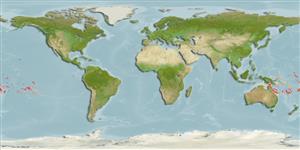>
Blenniiformes (Blennies) >
Blenniidae (Combtooth blennies) > Salariinae
Etymology: Cirripectes: Latin, cirrus = curl fringe + Greek, pektos, -e, -on = made of several parts solidly united (Ref. 45335); jenningsi: Named for Mr. Jennings of Swains Island.
Eponymy: Alexander Hutchinson Jennings (ca: 1896–1958) was the grandson of Eli Hutchinson Jennings who took possession of Swains Island, American Samoa (1856). [...] (Ref. 128868), visit book page.
More on author: Schultz.
Environment: milieu / climate zone / kisaran kedalaman / distribution range
Ekologi
laut dasar (demersal); kisaran kedalaman 0 - 10 m. Tropical; 5°N - 25°S
Pacific Ocean: Gilbert Islands to the Tuamoto Islands.
Length at first maturity / Size / Weight / umur
Kematangan: Lm ?, range 4 - ? cm
Max length : 7.6 cm SL jantan/; (Ref. 529)
Duri punggung (Keseluruhan (total)) : 12 - 13; duri punggung lunak (Keseluruhan (total)) : 15 - 16; Duri dubur: 2; Sirip dubur lunak: 15 - 17; vertebrata, bertulang belakang: 31 - 32. Diagnosis: Dorsal fin XII, 15, membrane attached to caudal fin, with deep notch above last spine, first spine almost same or slightly higher than second; anal fin II, 16; pectoral rays 15; pelvic fin I, 4; caudal fin procurrent rays 10-14. Vertebrae 10 + 21. LL, without scales and scalelike flaps; LL tubes 2-11 (usually 5-9), canal ends below 15th dorsal ray to caudal-fin base. Upper lip crenulae 41-47. Gill rakers 19-24. Cephalic sensory pore complex. Cirri, supraorbital 2-4, nasal 8-19; nuchal 34-44, row uninterrupted, without nuchal flap, cirri connected at their bases by a membranous ridge. Adults and juveniles anterior body light rose with black spots and 2 broad bars, posteriorly dark purple or blue with white spots, cirri pale. Ophioblennius overall cream with small dark brown spot on posterior of lower lip (in alcohol) (Ref. 529).
Body shape (shape guide): fusiform / normal; Cross section: oval.
Facultative air-breathing in the genus (Ref. 126274); Adults inhabit shallow coral reefs (Ref. 529). Oviparous. Eggs are demersal and adhesive (Ref. 205), and are attached to the substrate via a filamentous, adhesive pad or pedestal (Ref. 94114). Larvae are planktonic, often found in shallow, coastal waters (Ref. 94114).
Oviparous, distinct pairing (Ref. 205). Urogenital orifice of male genital papilla located basally behind a single slender filament on a fleshy swelling behind anus; testes bulbous with length equal to its width (Ref. 529).
Williams, J.T., 1988. Revision and phylogenetic relationships of the blenniid fish genus Cirripectes. Indo-Pac. Fish. (17):78 p. (Ref. 529)
Status IUCN Red List (Ref. 130435: Version 2025-1)
ancaman kepada manusia
Harmless
penggunaan manusia
Perikanan: tidak ada kepentingan
Alat, peralatan
laporan khas
muat turun XML
Sumber internet
Estimates based on models
Preferred temperature (Acuan
123201): 25.2 - 29.1, mean 27.4 °C (based on 304 cells).
Phylogenetic diversity index (Acuan
82804): PD
50 = 0.5000 [Uniqueness, from 0.5 = low to 2.0 = high].
Bayesian length-weight: a=0.01047 (0.00461 - 0.02381), b=2.98 (2.79 - 3.17), in cm total length, based on LWR estimates for this (Sub)family-body shape (Ref.
93245).
Trophic level (Acuan
69278): 2.0 ±0.00 se; based on food items.
Daya lenting (Acuan
120179): Tinggi, Waktu penggandaan populasi minimum kurang dari 15 bulan (Preliminary K or Fecundity.).
Fishing Vulnerability (Ref.
59153): Low vulnerability (10 of 100).
🛈
